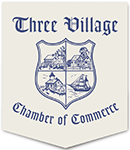About Us
3V Chamber History
Roy Dragotta, a Setauket attorney, founded the Three Village Chamber of Commerce in 1969, becoming Acting President and then President. Mr. Dragotta worked diligently to bring businesspeople, civic and religious leaders, and Stony Brook University faculty together. His efforts laid the groundwork for our present-day successful organization. After Roy Dragotta, Al Curson, Vice President of Marine Midland Bank, served as President.
The Chamber’s presidency was passed on to the legendary Harold Pryor former President of the United Transportation Union, Long Island Railroad, in 1978. Mr. Pryor’s warm personality and vivacious character soon brought the Chambers’ membership up to over a hundred members. His contributions to the Chamber and the community will always be admired and remembered. In 1996, Mr. Pryor died suddenly; not only the Chamber, but the Three Village Community greatly felt his loss.
Building on the commitment and accomplishments of our past presidents, the 3v chamber is more vibrant and proactive than ever.
Our continuing goal is to promote economic and business development, while still maintaining the quality and character, in the Three village are and beyond.
3V Heritage
The Three Village area of Brookhaven Town comprises the incorporated villages of Old Field and Poquott and the hamlets of the Setaukets and Stony Brook. Brookhaven is the largest town in Suffolk County, encompassing 323 square miles. The Three Village area is bordered on the north by Long Island Sound, on the west by St. James, on the east by Port Jefferson and on the
south roughly by the Nesconset Highway.
The Three Village area has retained a sense of time and place belonging to past centuries. This is so because of the preservation of numerous old houses, aggressive rehabilitation campaigns and a watchful citizenry with dedicated individual effort and the work of historical and preservation organizations.
Landmarks open to the public include the 1751 Stony Brook Grist Mill, the circa 1706 Thompson House, the circa 1665 Brewster House, the circa 1730 Sherwood Jayne House, the Long Island Museum, the Stony Brook Rehabilitation Shopping Center, the Reboli Center, the Jazz Loft, the Gallery North Art Center, the Three Village Historical Society History Center, the 1891 Emma S. Clark Memorial Library and the Old Field Lighthouse. Historic houses of worship include the 1889 All Souls Episcopal Church, the 1860 Stony Brook Community Church, the 1729 Caroline Episcopal Church, the 1812 Setauket Presbyterian Church and the 1870 Setauket United Methodist Church. Parks include the Avalon Park in Stony Brook, and the Frank Melville Memorial Park and Sanctuary in Setauket. There are also many walking trails, wetlands, harbors, bays, creeks and beaches to explore.
The Three Village area has eight Federal-style brick school buildings including the 1951 Setauket School designed by noted architect Richard Haviland Smythe who also designed the area’s two historic post offices. The State University at Stony Brook, more than half of which is in Setauket, has cultural attractions featuring theaters, concerts, art exhibits, a university library, a Special Collections archive which includes an original 1779 letter from General George Washington to his spy chief Benjamin Tallmadge, regarding the Three Village Revolutionary War Culper Spies. It also includes an extensive world- wide map collection.
There is a long list of strikingly beautiful private historic homes including more than 70 pre-Revolutionary War homes. Connecting the homes and other structures are the stories of the people: the Setalcott Native Americans, English settlers, African American slaves, colonial farmers, Revolutionary War Culper Spies, Patriots and Loyalists, ship builders and ship captains, artists and musicians, immigrants and factory workers, summer boarding homes and tourists, World War heroes and veterans.
Ward Melville was instrumental in maintaining the old-world character of the Three Villages. He was a visionary who started work in Stony Brook in 1940. He and his father Frank Melville, Jr. are credited with conceiving of Stony Brook, Setauket, and Old Field as a cohesive three village district. While not a formal municipality, the concept is an accepted notion and can be seen in the names of the stores and churches, and the local newspaper, the Three Village Inn, not to mention the Three Village school district.
These stories and more are the fabric that defines the Three Village area. Its beauty and attraction are the result of the actions of the men and women who settled here. Its individuals and organizations are the glue that makes this a special place to live and work.
